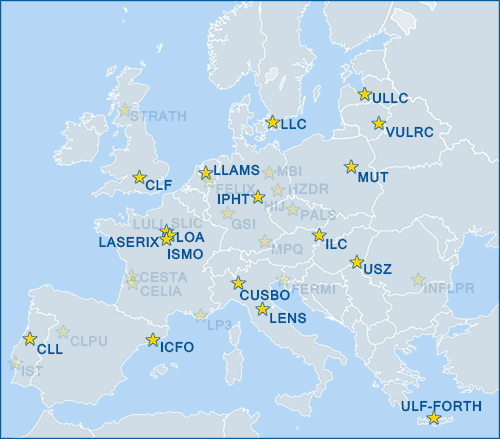BIOAPP-Biomedical Optics for Life Science Applications
 | |
|---|---|
|
Schematic representation of THG microscopy (left panel)THG images of human brain tissue, recorded |
This JRA will pursue three main objectives addressing key developments of innovative workstations and methodologies. These range from the investigation of single bio-molecules and single cells to in-vivo microscopy on living animals to the development of biomaterials and diagnosis tools for human diseases.
Objective 1: Bioimaging and biosensing. The first objective is to expand LASERLAB-EUROPE offer in terms of imaging devices, spanning from the nano (molecule) to the micro (cell) and macro (tissue and animal) scale, with emphasis on improving performances, imaging functions, combining approaches and meeting the User needs. Combining different devices and optical approaches, a multiscale imaging concept will be developed for studies in developmental biology, neuroscience, oncology and cardiovascular medicine. Multimodal microscopy is receiving increasing interest among biologists and clinicians due to its unique properties, which may include label-free tissue imaging, non-invasiveness, deep-tissue penetration, and specificity.
Objective 2: Bio-materials. The second objective is to research and further develop novel biomaterials and their optical characterization or fabrication thanks to the technology offered by LASERLAB-EUROPE partners. In particular, special attention will be devoted to advanced laser based bio-fabrication, photo-induced drug delivery and theranostics (synergy with JRA ILAT on IR-laser sources), bio-optofluidics, 3D laser processing for cell culture, biomaterial implants and bio-fluidic, and lab-on-a-chip systems. Also, biomimetic surface micro/nano patterning for tissue scaffolds and active/responsive biomedical implants will be available within LASERLAB-EUROPE.
Objective 3: Translational research. The third objective of this JRA is to translate new concepts and advanced laser-based techniques into solutions appropriate to be implemented in clinics. LASERLAB-EUROPE will support translation from basic concepts at the laboratory level up to the first demonstration of a prototype with validation in the lab. The clinical validation/trials will be performed in Hospitals associated with the project. Furthermore, an impellent need, which is often stressed by authoritative institutions like National Institutes of Health (NIH), is the quantitative assessment and quality control of new instruments to be used in clinics. This requirement is important to: (i) improve reproducibility and reliability of clinical studies; (ii) base the design of new instruments on solid quantitative laboratory tests; (iii) facilitate translation of novel techniques to clinics; (iv) provide reliable tests and implement in standards. Given its wealth of unique workstation with top-class performances, its expertise on accurate characterization, its widespread EU dimension, and the links to applications, LASERLAB-EUROPE is the perfect framework for a leading role in the optical characterization of tissue-equivalent phantoms, biometric measurements, and the proposal of protocols to assess the performances of novel optical tools in clinics or biology against clinically-matched parameters.
Coordinator: Francesco Pavone
Participants
 |
|
Subcontractor
IPHT, Jena, Germany

